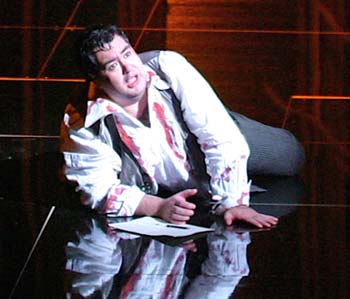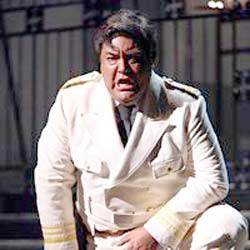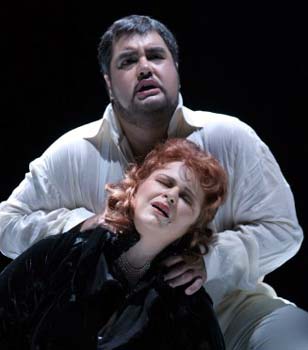|
| |
| |
BIOGRAPHY |
|
|
In 2013 Ricardo Tamura made his successful debut at the Metropolitan Opera New York as CAVARADOSSI and the press enthusiastically commented:
“Ricardo Tamura sang with radiant tone, a true lirico-spinto tenor with dramatic power and precision”.
Since then, TAMURA has become a regular guest of the Met, singing parts such GUSTAVO, DON CARLO, TURIDDU or CANIO.
Born in Brasil, Ricardo Tamura first studied geology at the Sao Paulo University. Having completed this studies, he began studying singing at the Julliard School in New York on the recommendation of Licia Albanese. He completed his musical education at the Accademia Chigiana in Siena and the Accademia Verdiana in Busseto with Carlo Bergonzi. His first engagement brought him to the Zurich Opera House, where he was a member of the International Opera Studio.
Since then, the artist, which is hailed by the press as being “absolutely secure in the high registers”, has sung more then 50 parts in operas, operettas and musicals.
Ricardfo Tamura is much dedicated to the Italian repertoire, especially the works of Giuseppe Verdi and Giacomo Puccini. His repertoire includes such roles as DON CARLO sung at the Nuremburg State Theatre, the German Opera at the Rhine Dusseldorf/Duisburg, RODOLFO, PINKERTON, CAVARADOSSI,
CALAF, which he sang lately at theVienna Popular Opera and at the Erfurt Cathedral Festival, DES GRIEUX and RICCARDO or RADAMES, which he also sang at the Arena di Verona. One of his most interpreted roles is CANIO, which he performed a.o. at the Schwerin Castle Festival and under Alexander Soddy in Klagenfurt. He succeeded with OTELLO at the Kassel State Theatre and at the Hannover State Theatre. Here, he also portrayed CALAF, BACCHUS, TURIDDU and CANIO. But Ricardo Tamura is also at ease with the French and the German repertoire. He sang BACCHUS a.o. at the Welsh National Opera Cardiff and the Nuremburg State Opera and in 2013 he made his successful debut as TANNHÄUSER.
His first radio transmission took place in 2005, as he sung with the WDR Orchestra (West German Radio Orchestra) in Alfredo Keil’s Portugese National Opera ‘Serrana’ at the Dresden Semper Opera. In 2006, his first CD recording – a total recording of Hans Werner Henze’s ‘Das Wundertheater’ – was published. Ricardo Tamura’s interpretation of Chafalla on this record was particularly praised by the composer. The most particular highlights in the same year included a concert on the occasion of the 150 anniversary of Puccini with the Nagoya Philharmonic Orchestra in Japan and an open-air concert for a 60.000 audience at the Luitpoldhain in Nuremberg.
In 2016 Ricardo Tamura sang for the first time CALAF at the Metropolitan Opera New York under Fabio Luisi and he made his debut as DES GRIEUX in ‘Manon Lescaut’ at the Hannover State Opera. At the opera houses of Pisa and Goldoni, he also was DES GRIEUX and he sang concerts in the Meisterhalle in Nuremburg and in Tokyo. Lately, he enjoyed great successes as CALAF at the Leipzig Opera House, as DON JOSÉ at the Nuremberg State Theatre, as CAVARADOSSI and DON JOSÉ in Koblenz and as RIENZI at the Kaiserslautern Theatre.
In the season 2021/2022 he portrays CAVARADOSSI in “Tosca” and MASANIELLO in “Die Stumme von Portici” at the Kassel State Theatre.
|
|
|
| |
| |
| REVIEWS |
| |
| Nationaltheaater Mannheim – Turandot - CALAF |
| As a cover for the general rehearsal and for the premiere, the opera could gain the Brazilian tenor Ricardo Tamura, who already sang the Tatar prince in 2015 at the Wichita Grand Opera. ( a video of the complete performance can be found on YouTube) In Mannheim he particularly convinced with his vocal penetrative power and long lasting final tones (like in the final of the first act).
|
| Das Opernglas 12/2023 L.-E. Gerth |
| Nationaltheater Mannheim – Musensaal im Rosengarten – Turandot konzertant - CALAF |
Ricardo Tamura, who jumped in on short notice for the role of Calaf, sang with a timbre which was dark and yet thrilling – a voice that seemed to be telling stories from ancient times. His “Non piangere, Liù” started with an urgent intensity, which slowed down into a seemingly endless melancholy to finally accelerate in the final of the first act. Here, Tamura didn’t only show his aesthetic sensitivity but also a comprehensibility for the complexity and the beauty of the fading moments in Puccini’s score.
He showed an aesthetic brilliance yet sometimes he lacked the necessary power to entirely assert himself against the monumental orchestra. Nevertheless, his performance is admirable, especially given that he jumped in only a few days ago.
|
Wochenblatt Reporter
wochenblatt-reporter.de |
| Staatstheater Kassel - Die Stumme von Portici - MASANIELLO |
| Ricardo Tamura has a beautifully rounded and forthright tenor voice with plenty of radiance, which he effectively uses to portray the role of Masaniello.
|
| J. Gahre, DAS OPERNGLAS 6/2022
|
| Staatstheater Kassel - Tosca - CAVARADOSSI |
| Ricardo Tamura is well-known in Kassel and reminds of his great performances of former years. |
OMM
www.omm.de |
| Ricardo Tamura sings Cavaradossi with smoothly radiating high notes (quite different from the cast at the Salzburg Festival recently). |
NMZ
www.www.nmz.de |
| Klagenfurt Theatre - Cavalleria Rusticana - TURRIDO - I Pagliacci - CANIO |
| Ricardo Tamura sings both Turiddu and Canio beatifully timbred, with lots of melodiousness, power and secure high registers. |
| Der Neue Merker |
| Ricardo Tamura sings both Turiddu and Canio with a beautiful, powerful tenor voice and magnificant high notes. |
| Kleine Zeitung |
| Ricardo Tamura is pure tenoral listening pleasure |
| Kronen Zeitung |
| Metropolitan Opera New York - Tosca - CAVARADOSSI - December 2013 |
Tenor Ricardo Tamura triumphs in Tosca at Met debut
'At the beginning of the first act, Ricardo Tamura sang “Recondita Armonia” with radiant tone, a true lirico-spinto tenor with dramatic power and precision ending with a resounding “Tosca, sei tu.” Tamura sang passionately in the jealousy duet “Qual occhio al mondo” and he and his Tosca, the acclaimed American soprano Sondra Radvanovsky had very good chemistry onstage.
In the second act Tamura’s long held triumphant cries of “Vittoria, vittoria” brilliantly soared through the house. He shows remarkable breath control and mastery of the Italian style.
The final act offered us a ravishingly sung “E luceven le stelle” with caressing style, soaring power and exquisite dimuendos, earning Tamura a prolonged ovation.
Tamura’s “O dolci mani” duet with Tosca just before his execution in Act Three was sung with both sweetness and abandon. There were cheers and bravos when Tamura took his solo bow at the end of the opera.' |
| Brooklyn Daily Eagle |
| |
|
|
| |
| |
| ON STAGE |
 |
| Theater Osnabrück - Tosca - CAVARADOSSI |
| |
 |
| Theater und Philharmonie Thüringen - OTELLO |
| |
 |
| Theater Detmold - Un ballo in maschera - RICARDO |
| |
|
|
|